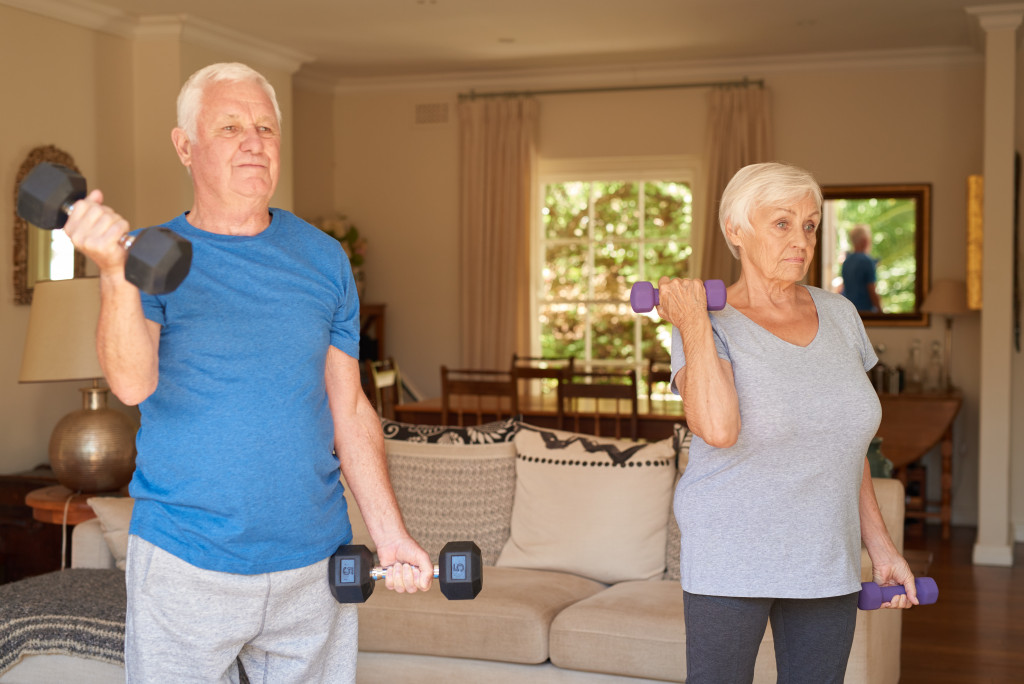The Covid-19 pandemic has forced older adults to move less because of the restrictions and shelter-in-place rules imposed by the government. Seniors who were used to taking brisk walks to exercise found themselves settling for indoor activities that didn’t require much movement.
Unfortunately, leading a sedentary lifestyle increases your risk of developing chronic conditions like heart disease, type 2 diabetes, depression, and anxiety. It might also worsen the conditions you already have.
Research suggests that older adults who exercise regularly benefit from a stronger immune system and mental well-being, as well as improvements in cardiovascular, respiratory, and neuromuscular health. Exercising regularly also helps you maintain your independence.
Exercise at Home
It can be difficult to find the motivation to exercise at home, especially if your only view while walking around is the walls of your house, your garden, or your gate. But there are ways you can keep fit indoors without getting bored.
Before you do, make sure to consult your primary care physician. Ask them if there are any limitations you might have. For instance, people with heart disease, hypertension, and arthritis may need extra safety measures during exercise.
And if you develop symptoms during your workout, like shortness of breath and chest pain, stop immediately and contact your doctor right away.
Choose Which Exercises to Do
According to the National Institute on Aging, there are four main types of exercise:
Endurance
Also referred to as “cardio” or aerobic activity, endurance exercises help improve heart health and lung function and prevent or delay the development of common conditions in older adults. Improving your endurance helps you perform daily activities for longer periods of time without feeling tired.
Examples of no-equipment endurance exercises you can do at home are:
- Brisk walking on a level surface (while watching the news)
- Gardening and yard work
- Climbing stairs
- Marching in place (while mixing pancake batter)
- Dancing (to your favorite music)
Strength
Strength training exercise makes your muscles work harder, which, in turn, makes them stronger. Strength training isn’t just for athletes, bodybuilders, or people who want to bulk. It improves your strength, making everyday activities like carrying groceries, climbing steps, and moving furniture easier to do. It also boosts metabolism, increases bone density, and reverses physical frailty.
Here are some strength-training exercises you can do.
- Lifting weights (the chair will do)
- Resistance band exercises
- Squats to chair
- Incline push-ups (on a soft space, in case you slip)
- Leg lifts
- Wall slides

Balance
According to the CDC, approximately 25% of individuals 65 and older experience a fall. Falls can be very dangerous to older adults, possibly resulting in contusions, abrasions, and fractures of the hip and wrist. When doing balance exercises, make sure there is a sturdy chair or someone with you who can support you if necessary.
Balance exercises can help with fall risk reduction. Here are some you can do at home.
- Tai chi
- One-leg stand
- Heal-to-toe walk
- Step-ups
Flexibility
Stretching exercises help improve the range of motion in your joints, allowing you to move around with ease. You can reach down to tie your shoes or reach up to get a dish on a high shelf without feeling painful niggles in your back and legs. Staying limber improves your posture, which helps banish back pain.
To get started, you can try simple stretching exercises like the following:
- Shoulder/upper arm stretch
- Hamstring stretch
- Lower back stretch
Do not hold a stretch too long, as this can strain your muscles and put you at risk for injury. Start by stretching for 10 seconds, and gradually increase the time spent holding a stretch as you get used to it. You may also try looking up yoga for older adults.
The National Council on Aging (NIA) recommends performing all four types of exercise, but you don’t have to do them all on the same day! Get at least 150 minutes of endurance exercise per week, two or more days of strength training per week, and balance and flexibility exercises on days you don’t perform strength routines.
Connect with Others
One of the most enjoyable parts of exercising outside was to meet people and socialize with friends. Since this isn’t an option for many during the pandemic, an alternative is to connect with others online.
You can start a fitness group on Facebook or other social media platforms and add your friends. Or you can join an existing group. Some exercise websites and apps have their own communities, too. You may also hire a virtual fitness instructor if you prefer so that they could supervise your workouts.
Don’t Forget Your Nutrition!
Exercise and a healthy diet go hand in hand. To get the most out of your workouts, support it with food appropriate to your specific calorie, health, and nutrition needs. Consume a variety of meats, fruits, vegetables, and nuts.
If you’re having trouble incorporating certain nutrients and minerals into your daily meals, take supplements. NIA recommends calcium, vitamin D, vitamin B12, and vitamin B6, as well as vitamins A, C, and K, manganese, and potassium.
Specially formulated supplements like Go-Out Daily Maintenance contain antioxidants that prevent or delay cell damage. Antioxidant-rich food such as tart cherries, blueberries, and artichokes, are also high in fiber, protein, and other nutrients.
Get Active and Be Healthy
Stay-at-home orders don’t have to mean sitting all day and looking at a screen. Too much time spent sedentary will only make healthy aging difficult. With a little motivation, determination, and creativity, you can stay safe during a pandemic while enjoying the physical and mental benefits of exercise.




